I’ve been raising chickens in my backyard for more than 13 years, making my own chicken feed for 12 years, and fermenting it for the majority of that time.
Lacto-fermentation is a discovery I made while trying to give my hens a more wholesome diet, and it’s probably one of the easiest things you can do to improve their health and their eggs (while saving a bit of money at the same time).
In a nutshell, fermented chicken feed is probiotics for your chicken. It’s a wet mash (the chicken keeper’s term for moistened food) created by lactic acid fermentation (the same type of fermentation that occurs naturally in sauerkraut).
Just like kraut, it contains all the bacteria that’s good for your gut: Lactobacillus, Leuconostoc, Pediococcus, and other beneficial bacteria and yeasts.
I’ve been fermenting my chicken feed off and on since I switched to using only whole grains and seeds, and I wanted to go through a 50-pound bag of scratch grains quickly and efficiently.
(Learn from my mistake: Do not buy 50 pounds of scratch if you have a small flock of chickens that forages most of the day. They will peck and scratch the ground regardless, and if you already feed them other grains and seeds, they will simply ignore the scratch you toss on the ground.)
So, how does lacto-fermentation work?
The first day of soaking grains greatly improves their digestibility by reducing the phytic acid and enzyme inhibitors found in all grains, seeds, and legumes.
By the second day, lactic acid bacteria begins the process of fermentation by consuming the sugars in the grains and multiplying in great numbers, producing lactic acid. The lactic acid, in turn, makes the environment unsuitable for bad bacteria, leaving behind only beneficial microbes. This process preserves and enhances food.
As long as the grains stay submerged in their lactic acid “bath,” they will be preserved indefinitely (though there comes a point when the grains can become too sour and thus, not very tasty… just ask anyone who has had over-fermented kimchi).
Why you should ferment your feed
We all know that lacto-fermented foods are good for us; yogurt, sauerkraut, kimchi, and kombucha are among the foods touted for their nutrient-dense and enzyme-rich benefits to our health.
Lacto-fermented food contains live Lactobacillus, a beneficial bacteria that helps normalize the acidity in our stomach, provide digestive balance, aid in the absorption of nutrients, neutralize toxic compounds, and strengthen overall immunity.
But what about for chickens?
According to research, fermented feed has been found to increase egg weight, shell weight and shell thickness; boost the chickens’ intestinal health by forming a natural barrier to acid-sensitive pathogens like E. coli and Salmonella; and lowered their consumption of feed (due to their bodies digesting the fermented feed more effectively), according to a British Poultry Science study from 2009.
Another 2009 study by the African Journal of Biotechnology concurred that fermented feed reduces the level of anti-nutrients found in the grains and seeds, and greatly improves the bioavailability of vitamins and minerals during digestion.
Not only does fermentation preserve the vitamins in your grains, it also creates new vitamins, primarily B vitamins like folic acid, riboflavin, niacin, and thiamin.
In short, fermenting your chicken feed leads to better eggs, better hen health, and lower feed costs. Less feed also means less poop, which none of us can complain about!
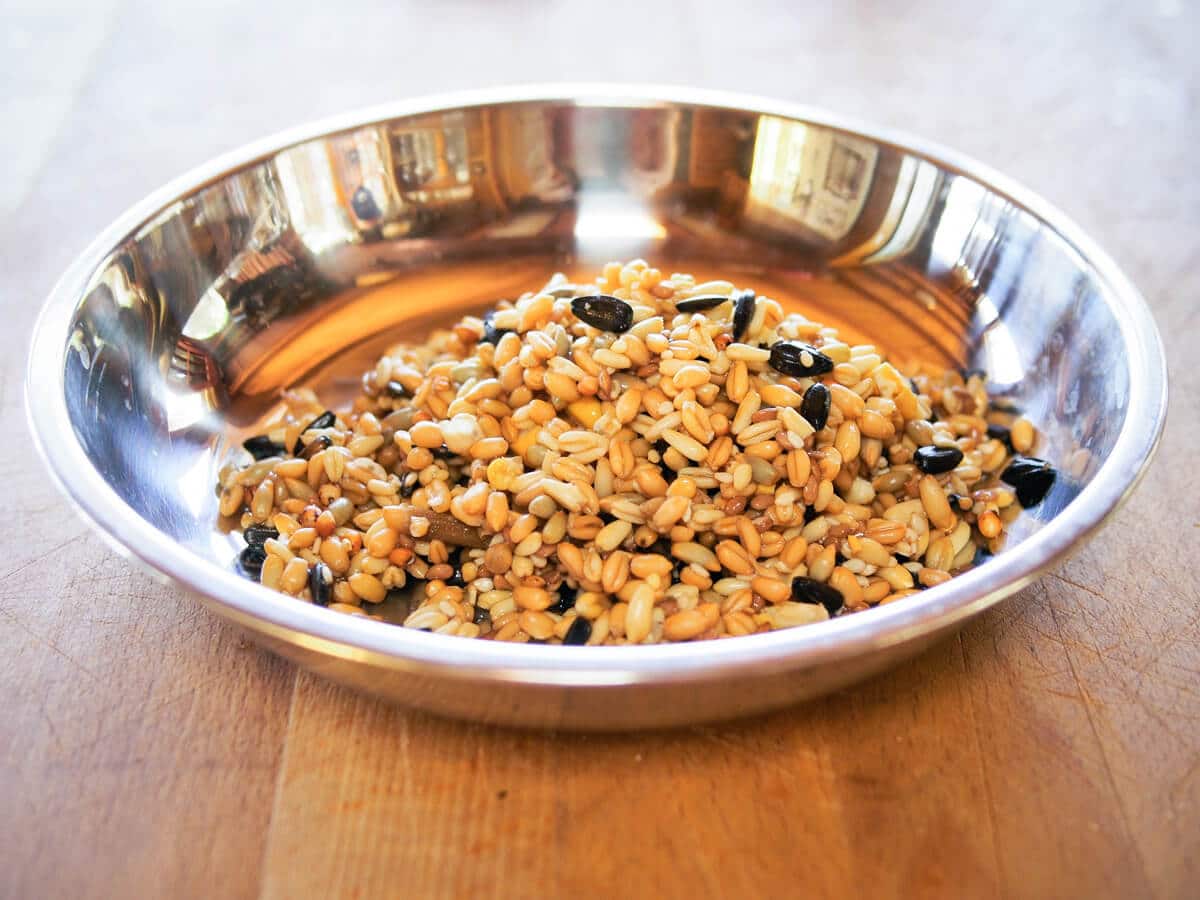
Disclosure: If you shop from my article or make a purchase through one of my links, I may receive commissions on some of the products I recommend.
How to ferment chicken feed
Feed fermentation can be broken down into four simple steps:
- Fill a container halfway with feed.
- Add enough (dechlorinated) water to submerge the feed.
- Stir and let it sit for a few days to start the fermentation process.
- Once you see active bubbling, your feed is fermented and you can give it to your chickens.
For a flock of three hens, I use a gallon-size glass jar. Larger flocks may require five-gallon buckets or storage bins, so long as they come with a lid.
If you can only source a plastic container, try to ensure it’s BPA-free. The acids in lacto-fermentation can increase the chances of BPA leaching into your liquid, and while there hasn’t been any concrete studies on how much BPA is actually leached, I’d rather not take my chances.
What to buy
For fermenting chicken feed
For a better visual overview of the process, here’s what it should look like:
Step 1: Fill your container about one-third to one-half full with the feed of your choice.
You want to leave room for the grains to expand.
You can ferment any feed you currently give your chickens, whether it’s crumbles, pellets, scratch, or whole grains and seeds. The higher quality your feed, the more your chickens will gain from lacto-fermentation.
Try fermenting my homemade whole grain chicken feed (I also have a feed recipe with no corn in it), but leave out the brewer’s yeast as that will introduce alcoholic fermentation (whereas we want lacto-fermentation).
Step 2: Add enough dechlorinated water to cover the grains by a couple of inches.
Why dechlorinated water? Because most municipal water—the stuff that comes out of your tap—contains chlorine and chemicals designed to kill bacteria, including good bacteria.
You can use filtered water for lacto-fermentation, or simply set your tap water out for 24 hours to allow time for the chlorine to evaporate.
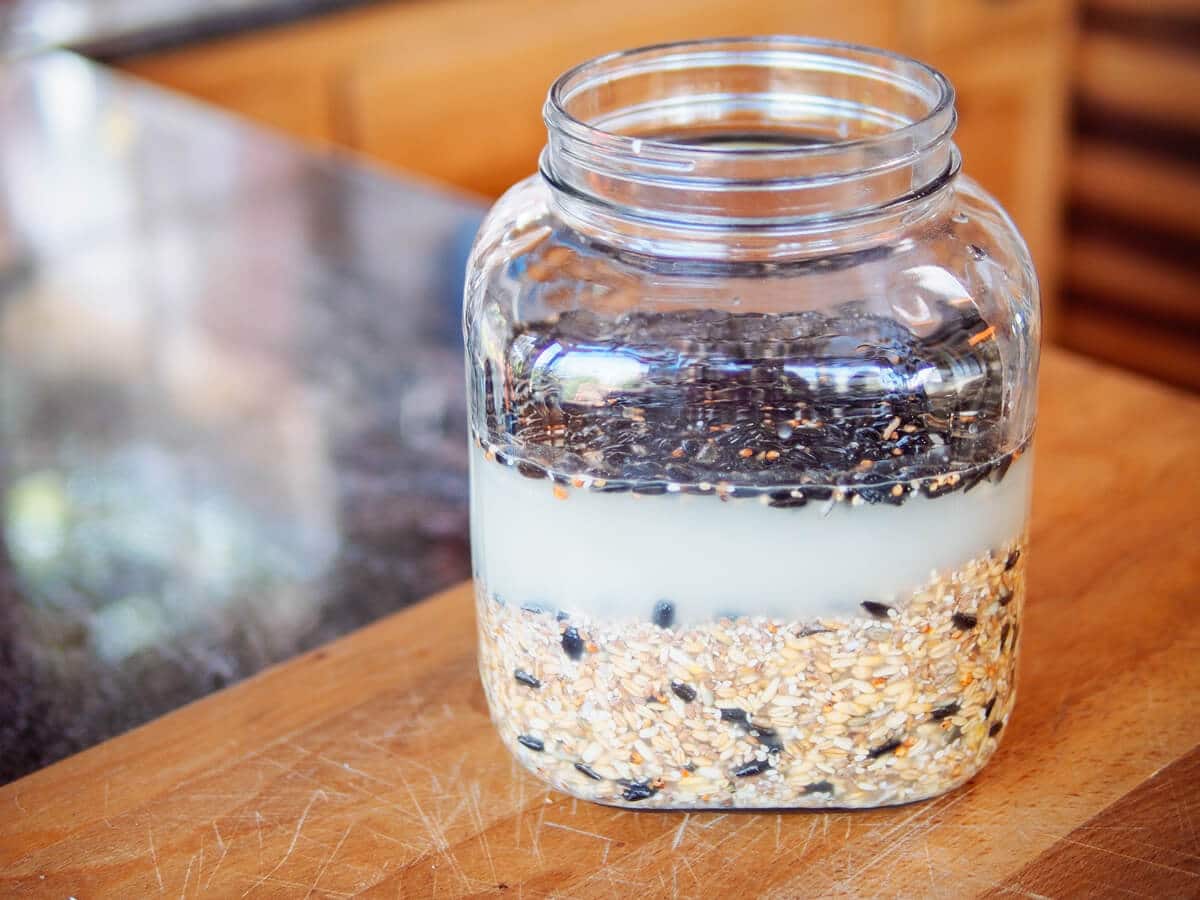
Step 3: Place a lid on your container and leave it out at room temperature for three to four days.
At least once a day, or whenever you remember, give the grains a stir and add more water as needed to make sure they stay submerged.
When you start to see a layer of bubbles on the surface of your liquid, voilà—you have lacto-fermentation in process. The bubbles are the off-gassing of carbon dioxide by lactic acid bacteria.
The water will appear cloudy and the top layer may seem filmy and foamy, but rest assured these are the normal effects of all that bacteria at work. You can simply stir the “scum” back into the feed when you see it.
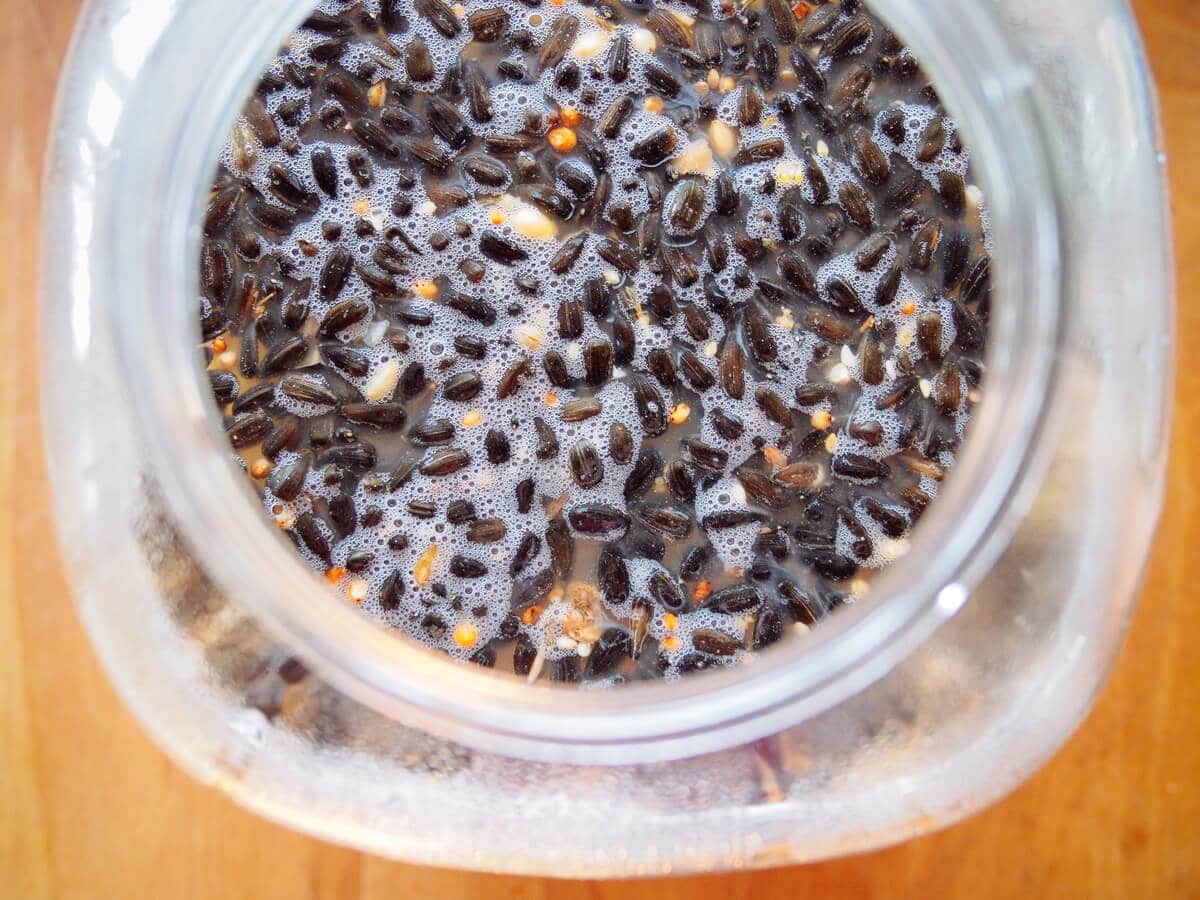
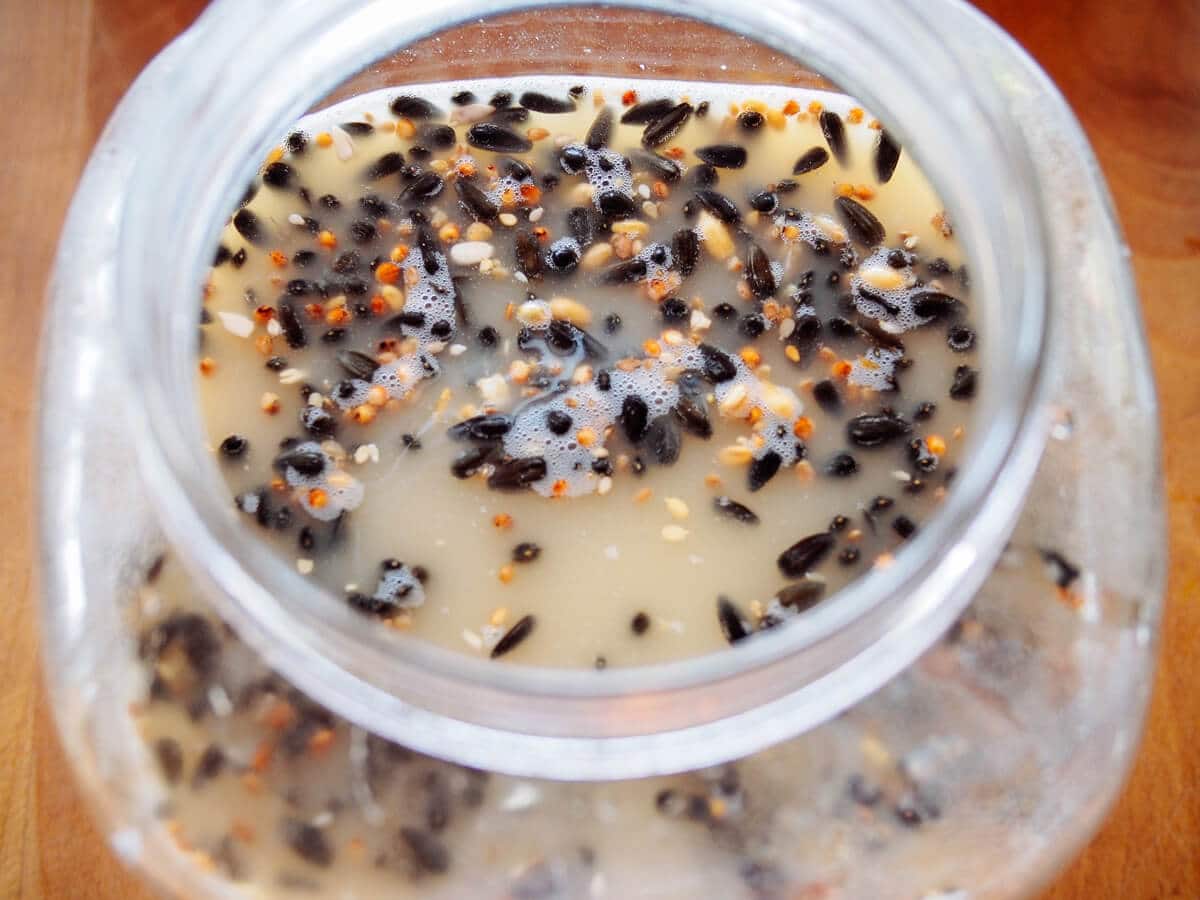
Properly fermented feed actually smells pretty good (if you like fermented food, that is)—fruity and tart, like yogurt. That sour smell indicates the presence of lactic acid.
If your fermented feed has an unpleasant odor, or smells strongly of alcohol or yeast gone wrong, your batch has likely gone bad. A rotten smell means you should discard the grains and start over again.
Quick Tip
Does your fermented feed smell alcoholic? Act fast—you can try to save your batch. Just add a tablespoon of unpasteurized apple cider vinegar (for every gallon of fermented feed) and let the acetic acid in the vinegar digest the alcohol and yeasts, thereby bringing everything back in balance.
You should never see mold in your fermented feed. Mold on your grains is a sign of air exposure. And moldy anything is no good, unless it’s cheese.
When you have mold, it means the oxygen in the environment is depleting the Lactobacilli in your lacto-fermentation. Always make sure your grains are completely covered in water and your container is sealed properly.
Step 4: Feeding time!
In three to four days, your feed should be fully fermented. Check by bubbles and by smell.
When it takes on a strong and sour smell, you can scoop out and strain the appropriate amount of grains for your chickens and feed it to them wet. Watch them go crazy for it!
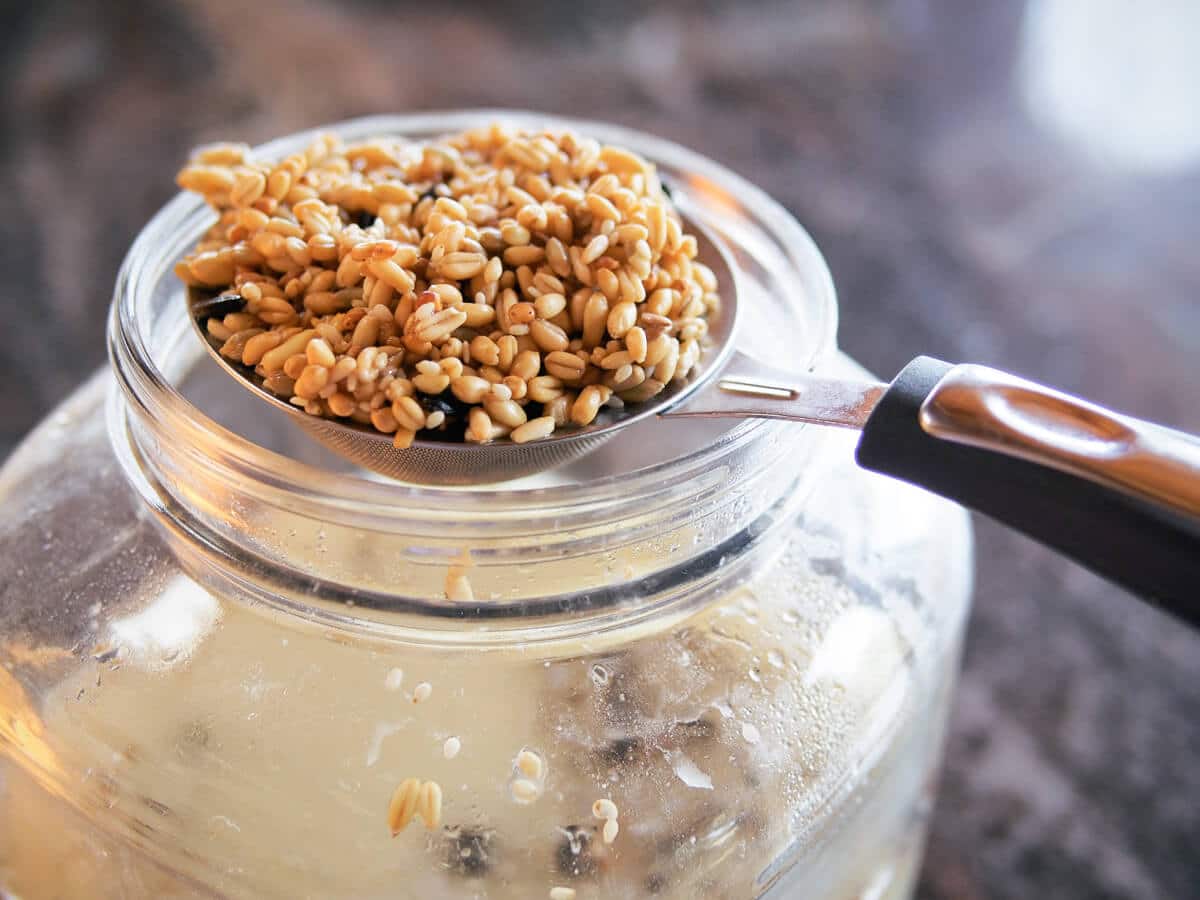
Keep it going indefinitely
Every time I strain an amount of fermented feed from my jar, I add the same amount of dry feed back into it.
Give a stir, re-cover with a lid, and strain more feed the next day. This is the easiest way to keep your lacto-fermentation going without starting over.
You can keep reusing the same liquid, especially since it already has all that good bacteria floating around in it, which speeds up the fermentation of new grains.
In my setup at home, I keep a jar of pre-mixed grains right next to my jar of fermented feed. This makes it simple to refill the ferment jar with new grains each time I scoop some out of the liquid.
The jars sit on a dark shelf in my kitchen, where the temperature typically hovers around 68°F to 70°F.
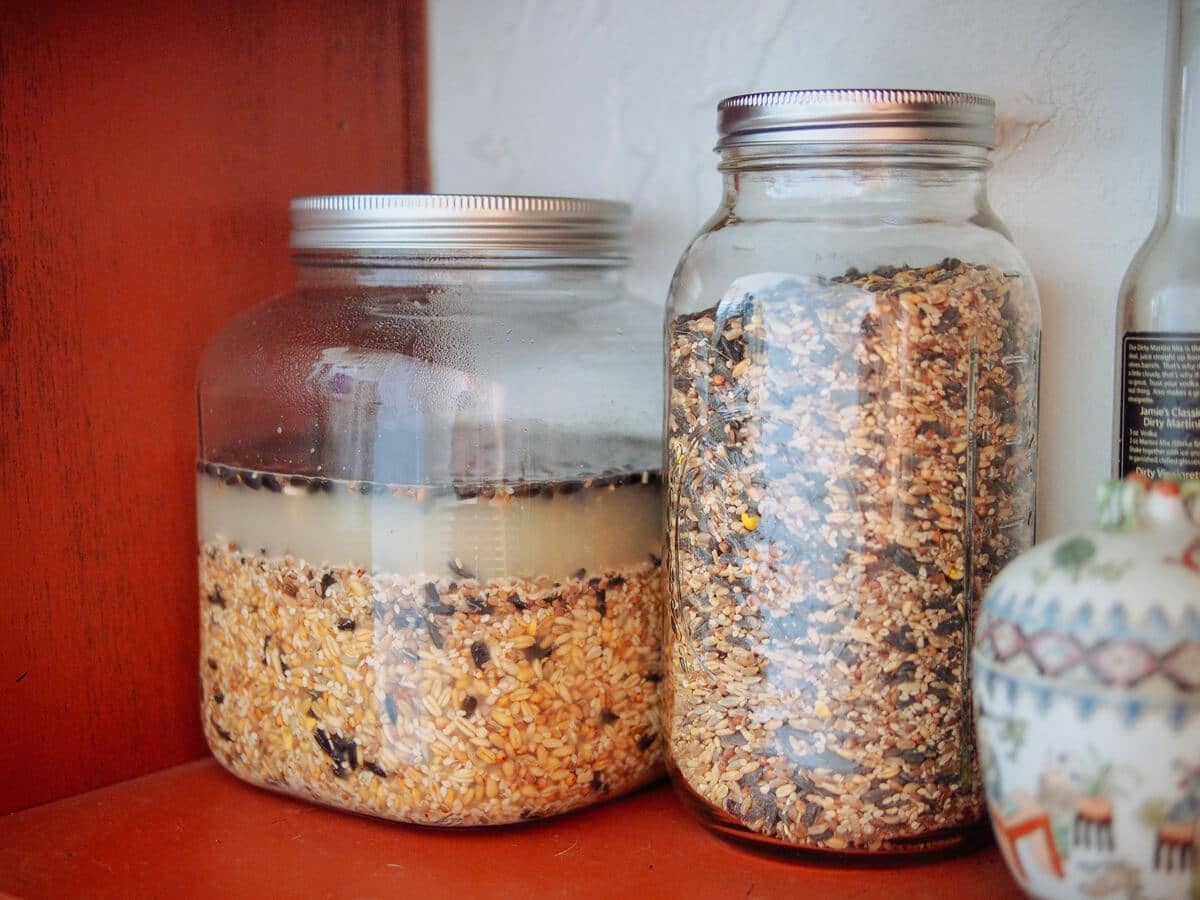
What I’ve learned after several years
In theory, you can reuse the ferment liquid indefinitely and it will just get better and better (and by better, that means it will contain an amazing amount of probiotic bacteria).
But I start new batches of fermented feed a few times a year, usually when I go out of town for at least a week and don’t want the feed to turn too sour.
If, after a long period of time, yours becomes slimy, sludgy, or stinky (a side effect of oxygen killing the good bacteria and introducing the bad bacteria), you should start again with fresh water.
I have never used a starter to start the lacto-fermentation, and you don’t have to either. Lactobacilli is already present in the air and on the surfaces of the grains, and in the right environment they’ll proliferate before you know it.
At most, your feed will be fermented by day four. I’ve read accounts from other people who add unpasteurized apple cider vinegar as a starter, but I think it’s unnecessary.
Vinegar contains acetic acid bacteria. We want lactic acid bacteria. While acetic acid has its own health benefits (and certainly won’t hurt if you decide to add a tablespoon or so to your chickens’ water or feed), it’s not useful as a starter for lacto-fermentation.
If you’re really impatient and want to get going right away, you can use the liquid from lacto-fermented pickles or sauerkraut to start your fermentation.
At feeding time, I bring the chickens a scoop or two of fermented feed and clear the dish when it’s empty.
I don’t leave fermented feed out for hours or days at a time, as the bacteria is most beneficial when it’s served fresh. Only leave enough feed out that your chickens can finish within half an hour.
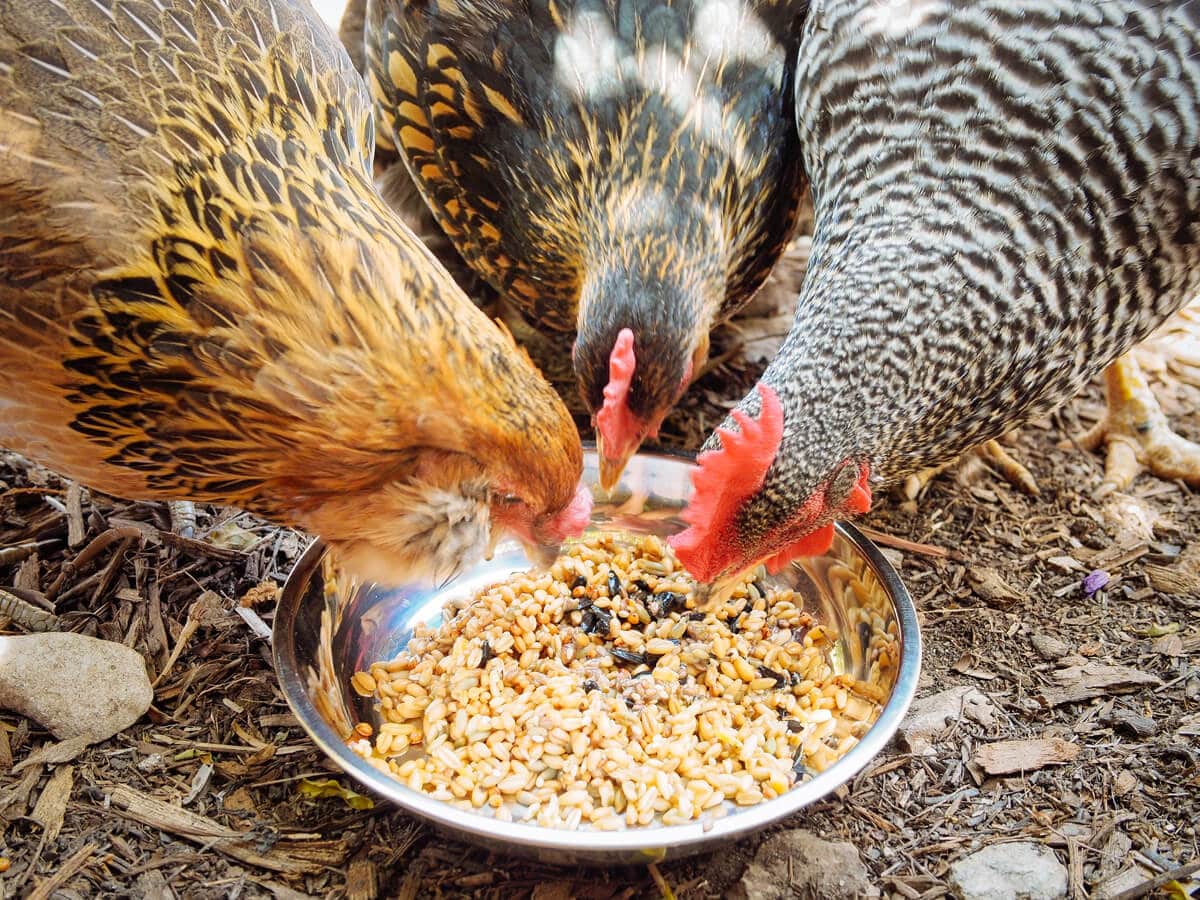
When I confine my chickens to their run all day (no foraging or treats), I’ve estimated that each one eats about one cup of dry feed per day.
When I give them fermented feed, it seems they eat half that amount. At the end of the day, their crops are nice and full. While this is no scientific study on how much less they’re eating of the wet versus dry feed, I think it’s safe to say they do eat less feed when it’s fermented.
I don’t give fermented feed to my chickens every day. This is mostly because I’m not always home, and lack the time and resources to bring them fresh feed every day. But I also believe in balance when it comes to food.
While I’ve yet to come across any reports of someone getting sick from consuming too many probiotics, I feel moderation is best. Most of us don’t eat fermented foods as our main course every day, and our chickens probably shouldn’t either.
I still provide fresh greens and dried grubs or mealworms (along with grit and oyster shells) when I give my chickens fermented feed. I still provide their regular dry feed (as a free-choice option) a few days a week, especially when I go out of town.
I’d say that they average half a week with fermented feed and the other half with dry feed. Since I started fermenting my feed, I’ve raised several generations of chickens (of various breeds) in two different climates, and they’ve all been as happy and healthy as can be!
This post updated from an article that originally appeared on May 27, 2013.
















Thank you for that information, will try on my chickens and turkeys.
I am an all organic kind of Momma Hen of my 5 laying girls and find your information so encouraging. I just purchased all the suggested elements from Azure Standard and mixed up a batch and keep in a BPA free tote. I have been sprouting my feed but will be upping the process to fermentation, starting today.
I am exceedingly grateful for your information. Thank you for making it available!
You’re welcome!
Thank you for your informative article! I may have started my fermentation process a little too early (too excited about getting my pullets I suppose). Is it OK for the feed to sit out for more than 4 days, ie 5-6 days? Of course still with daily stirring and making sure no mold, etc.
Should have tree containers for fermenting over three days, otherwise the feed you put in yesterday is not fermented…probably not the day before additive as well.
Yes, you can absolutely use a three-container system if you have the space for it. But even if you stick to only one container, soaking the grains for just a day helps reduce the anti-nutrients and makes them more bioavailable (even if they’re not fully fermented yet).
Saturday I started the fermentation process with scratch grain. Tuesday I feed it to my hens and they gobbled it up by Thursday their egg production doubled. I started about 30 pounds of scratch grained with black oil sunflower seeds added and will begin on Tuesday to give it to the hens.
I’m sold on this style of feed and waiting to see what it will produce in the young hens.
I have been fermenting food for years. It’s how i preserve my garlic year to year. Do not stir a lacto ferment. Doing so imparts oxygen back into the liquid which is exactly the opposite of what you want.
We don’t always ferment but we do always soak and of course the volume nearly doubles. Would you feed less or measure out the amount (1/4 C per chicken) pre soaking and give them all of it or do half or 3/4 the amount and soak it to double volume? I want to make sure they’re getting enough but we’ve been weighing like 3lbs of feed and soaking it for 12 chickens. Comes out to way more than 1/4-1/2c per chicken.
I’m excited to try your fermenting process. Thanks for the great write up.
My flock doesn’t free range much so I add grit to their feed. Do I need to add grit to the fermented feed?
Free feed the grit in a separate container. They’ll each eat what they need.
Oyster shell grit adds calcium for laying hens, which roosters don’t need, which is why I don’t put it in their feed – it’s unhealthy to feed roosters too much calcium.
That said, even if you keep only hens, it’s better to offer grit separately from their feed.
First time at fermented chicken feed, yesterday they loved it! Today it has mold……not sure what happened.
Love this idea! Can I ferment the grains in a metal bucket? TIA
I’ve been fermenting my feed and have given it to my ladies twice now (only had them for a week and they are now almost 19 weeks old). They don’t really seemed interested in what I’m putting out. Yesterday I put out their dry feed after an hour and they all acted like I had been starving them… what am I doing wrong?
It is very important to maintain the temperature at the 68 to 70 degrees that was given in this article. If the temperature gets too warm the batch will quickly Mold. I had this happen a couple times until I figured it out.
I am in Bahamas daily temperatures in 80’s my 50lb bag of scratch went moldy very quickly in the garage in big plastic bin
What to do ? I can’t afford this ?! Any ideas with limited materials .thanks.
Can a broody hen be left alone for two weeks ? Just a bowl of water ? Advise .
You can make continuous feeder using Pcv pipe
If a broody hen is on eggs that are fertile have food and water close to her
If no too break her broodiness!
I remove them from the nest every day dunk their bottoms in cool water or put her in a wire bottom cage with food and water. But no chicken should only have just water for an extended period of time.
Do you sell your homemade feed? I’d like to try it with my chickens before I buy a bunch of ingredients that they may or may not like.
No I don’t. I suggest buying just small amounts of those ingredients to try it out for your flock first (a lot of them can be found in the bulk bins of certain grocery stores). And the nice thing is, since you’re buying human-grade ingredients, you can use them yourself if your chickens end up not liking something.
My girls are 17 weeks old. I’m just getting ready to go switch them over to scratch and peck layer feed. My question is, how long do you leave the fermented feed out? If it is not eaten up by a certain time, do you discard it? Thank you.
I leave out just enough fermented feed that they can eat in one sitting. (Granted they may move around and come back to it, but usually they’ll finish within 30 minutes.) The amount will vary, so start with 1/2 to 3/4 cup per chicken and adjust from there. Their appetites will depend on the breed, time of year, and whether or not they free-range or get kitchen scraps.
Hi Linda,
Thank you so much for the help! I have my first jar fermenting on the counter!
It is very important to maintain the temperature at the 68 to 70 degrees that was given in this article. If the temperature gets too warm the batch will quickly Mold. I had this happen a couple times until I figured it out.
Can you do this with medicated chick starter? Introduce it? Or do I need to wait until they switch to layer feed?
You can ferment unmedicated chick starter, but I don’t know how medicated feed would react if it’s fermented. (I personally wouldn’t do it.)
Guide me to do it
One advantage of fermenting their food is that they’re far less likely to NEED medicated feed, which I don’t give my birds.
I also give organic unfiltered apple cider vinegar in their water, a tablespoon per quart of water, and have had few problems with illnesses in the roughly ten years I’ve been keeping chickens.
Should the lid be sealed, as in airtight? I’m asking because I read some where that the good bacteria multiplying during the fermentation need oxygen as well, and thus the container should be covered with cheese cloth or breathable cover. But you seem to suggest that allowing oxygen might cause mold.
No, not airtight. The bubbles in the fermentation process need a place to escape. I just put the lid on loosely.
Hello. I just found out about fermenting chicken feeds and I am considering it to be the topic of my undergraduate thesis. I just wanna ask if it is okay to ferment commercial chicken feed?
Yes you can, though results may vary based on the quality of the commercial feed.
My chicken feed before fermenting, smells awful. But it is the only locally grown organic non GMO feed I can get. When I ferment it, it smells even worse. It bubbles and there is no mold, and my chickens gobble it up. Any idea if the smell is normal since the feed stinks to begin with? I have been feeding it fermented for a few weeks now and don’t see any problems. I just wish it smelled more pleasant. Thanks!
What are the ingredients in your chicken feed? I’m not sure what would be included in a commercial feed to make it stink to begin with…
My chicks are approximately 10 weeks old and have not laid as of yet. They are currently eating crumble and I have just finished fermenting my first batch which they have eaten twice. I am going to switch to a whole grain diet that I plan to also ferment. I am wondering if I should start the switch with dry grains or with fermented dry grains?
You can go straight to fermented grain, but I would mix it in with the crumble for the first week or so to help your flock adjust to the new diet.
At what age is it ok to start feeding them your homemade grain recipe? And age for fermentated grains? Mine are 2 weeks old. If I do make the grains…should I then be giving grit and oyster shells?
My homemade grain recipe (found at https://gardenbetty.com/garden-bettys-homemade-whole-grain-chicken-feed/ and https://gardenbetty.com/homemade-whole-grain-chicken-feed-updated-and-now-corn-free/ ) is designed for laying hens. However, you can use my chicken feed calculator (https://gardenbetty.com/garden-bettys-chicken-feed-calculator-for-determining-your-protein-content/ ) to customize the feed for chicks, which require more protein. Any age of chicken will do well on fermented grains and seeds, so long as the feed is properly formulated to meet their nutritional needs. Grit should be provided free-choice to all chicks and chickens (in an appropriate size for their age), and oyster shells should only be given free-choice to layers.
how many hours is the best to fallow to attain the best result
The speed of fermentation depends on your ambient room temperature, but in general the grains should ferment in about 3 days.
nice
hi, just want to know like when the fermentation process competes & we drain the water than where to keep the fermented seeds that are ready for feeding, the same place like in room/kitchen or should be in cooler place like fridge.
We keep the fermented feed in the jar in a cool place. A kitchen counter or pantry should be fine. We also do not strain the feed until we serve it to the chickens. The grains stay submerged in the liquid and continue fermenting.
Thanks
When feeding fermented feed, do you need to also provide another source of protein? We have been doing fermented wheat for a few months and are noticing more and more feather loss. Thanks!
I ferment my regular whole-grain feed (recipe at http://gardenbetty.com/2013/04/homemade-whole-grain-chicken-feed-updated-and-now-corn-free/) which has the proper amount of protein for my flock. If wheat is the ONLY thing you’re feeding your chickens, fermented or not, you definitely need to augment their diet to make sure they’re getting enough nutrients.
Would a pickling jar work as well? It’s self darkening and I think it keeps a more constant temp because it’s ceramic, but it has a resting lid not a screw on, will this matter?
It will totally work!
I am new to this. What kind of “grains” are you talking about?
Grains and seeds that are part of a chicken’s feed, such as what I use in my custom feed here: http://gardenbetty.com/2013/04/homemade-whole-grain-chicken-feed-updated-and-now-corn-free/
Have you considered using airlocks on the jars (or buckets) to maintain a more consistent anaerobic environment? Also, what do you think about adding raw apple cider vinegar (with the mother) to give the ferment a jump start? I see some people also add whey … is this overkill and not a necessary use of resources? Thank you.
I don’t use airlocks since the grains ferment very quickly and I’ve never had a problem with mold. I also don’t add anything to jump-start the fermentation for this reason. This is as simple as fermentation gets. 🙂
Does it ever get too sour and thus the chicks won’t eat it?
I only ferment enough grains to last a couple of weeks, and haven’t had any problems with my chickens refusing them. I’m not sure when/if the grains ever turn too sour.
I have used Linda’s recipe for 3+ years and my chickens love it. I do continuous ferment in a crock where you take out what you need for that day and then add in more dry feed. Keep it going like you would sourdough starter or continuous brew kombucha. It works great!
Hi I’m a newbie at this and find your site an excellent source of information. Can raw rice be fermented and fed to adult hens?
Yes, you can ferment rice, but white rice is low in nutritional value, so I wouldn’t rely on it alone as a source of feed.
So I got a little ahead of myself and used hose water without letting it sit out for 24 hours for the chlorine or whatever to evaporate…did I ruin it all or could i leave it uncovered for 24 hours and it will still evaporate? Is it still salvageable?
The only concern with hose water is the chlorine found in municipal water sources, which can sometimes interfere with fermentation. It’s not the end of the world and your fermentation may still even work, but it’s a precaution to take if you’re not sure of the water quality. (Also, hopefully your hose is safe to drink from.)
Can I feed this to chicks also? I will be getting day old chicks soon and was wondering if I shouldn’t feed them fermented feed right away. Also, how do I know how much to feed them? I will be feeding them twice a day, and they will also get to go out on pasture. Thanks!
Yes, chicks can eat fermented feed. They will eat more and more as they grow, so start by setting out a small dish for them and adjust the amount based on how long it takes them to finish the grains at each feeding.
Great How to info on fermentation. Just wondering though if you sterilize your jars beforehand? I have read that chickens can get sick (just like humans) from E. coli and botulism. When fermenting (which is a form of preserving) the rules of food safety and handling is important. Unless stated in directions a lot of people don’t take on board the fact that it is just as important to handle food for animals just as carefully.
I sometimes put the jars through the dishwasher, but more often I only wash them with hot water and soap, and find that it’s sufficient.
Sourdough bread starter should help speed it up, that is a mainly lactic process. It suggests you could maintain a starter liquid in a similar way too, like give some nutrients leave for an hour, then fridge for up to a couple of weeks. Room temp for an hour, give small feed and leave until bubbles to reactivate.
Hi, I was wondering if you only put out a small amount of feed so that the girls will eat it all within thirty minutes, how many times a day do you feed them?
I only feed them the fermented grains once a day. You will need to experiment with the amount you leave out in order to gauge how much your chickens can eat.
You mention not using scratch grains here but mention in other articles you do use scratch grains. If I am using a mixed non-GMO feed from a local supplier (cheaper than making my own) that is whole grain, do I really need scratch grains? I ferment their feed as well as feed them wheatgrass. We use the the majority of wheatgrass for ourselves and let them eat the green close to the wheat berries along with the berries. We also give him extra SCOBYs from kombucha, ground eggshells, and of course a few veggie scrap treats. The chickens are free range as well. Do scratch grains really matter in this case as those ingred are what is basically in their whole grain feed?
When I first brought home my flock a few years ago, I did give them scratch grains — but I found it unnecessary after a while. Scratch is just another name for little treats that you toss out for them to peck and scratch through. Commercially bagged scratch contains corn as a primary ingredient, plus some other cheap grains. If you already give them those treats, a separate serving of scratch isn’t needed. They’re happy to scratch through anything you throw out for them!
My chickens LOVE fermented wheat. I also sprout some, along with oats. Since you posted pictures depicting mixed grains, I will try fermenting that next week! BOSS, some crumbles, cracked corn, the oats, and some field radish seeds from our local CO-OP… Thank you for the explanations.
You’re welcome! I know your chickens will enjoy it!
Siobhan Corr liked this on Facebook.
Crystal Downes liked this on Facebook.
Alicia Riley liked this on Facebook.
Cindy Riecke liked this on Facebook.
Carol Savonen liked this on Facebook.